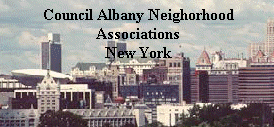But as the Council of Albany Neighborhood Associations
celebrates its 30-year anniversary, the neighborhood umbrella
group can boast of many changes spawned by its local activists.
On Oct. 4, CANA will celebrate its anniversary at a reception
and dinner at the University Club of Albany.
Back in the 1970s, Albany had a reputation for unfair
assessments, poor code enforcement and nobody to help but your
ward leader. And if he didn't like you, good luck pal.
Enter CANA, as the 25-member federation is called. Created in
1976, the group began to push for civic change from better
street sweeping to tighter budgets.
And in a city run by a Democratic machine, the leaders opted
for a nonpartisan movement.
"We felt we could achieve more that way than through
politics," said Harold Rubin, a retired state budget
analyst and CANA founder. "We didn't want city services as
a favor. We wanted it as a right."
The response from Albany's political bosses was decidedly
negative.
They want "instantaneous and complete code
enforcement," Corporation Counsel John Roe complained to
Mayor Erastus Corning 2nd in a 1976 letter. Roe recommended
action "to prevent the alligators from taking over the
swamp."
Some requests were simple. Like moving Zoning Board meetings
to the evenings, so people who worked during the day could
attend.
Others took some doing.
Creating a public comment period at Common Council meetings?
"It took about 10 years to get that," Rubin said.
"They had horrible thoughts about what was going to happen
(if people spoke). And it didn't happen."
Another innovation: Curbing the roads through Washington
Park. That stopped cars from parking on the grass. CANA also
pushed for a stronger Historic Resources Commission and a public
vote on school budgets.
What ultimately emerged, under the tenures of Mayor Tom
Whalen and Mayor Jerry Jennings, was dialogue between residents
-- from uptown and downtown -- and city administrators, members
say. CANA got city department heads to attend its monthly
meetings and answer questions, something unheard of under
Corning.
But code enforcement -- a central dilemma in the 1970s --
remains a problem.
This year's CANA study found Albany's code enforcement system
so outdated it remains "stuck in the management style of
the 19th century" and lacks clear rules and procedures.
"We want a system that is impartial, whether it is a top
builder that is calling in or it is Joe Blow," Rubin said
recently.
Deputy Fire Chief Robert Forezzi disagreed, saying Albany's
program is in the "vanguard" of other New York cities.
But lots of people still don't know who to call about code
violations, Rubin said. And investigation results aren't easily
found. "We want all this information available
online."
Currently, residents must file a state Freedom of Information
Law request to get code complaint information, which can take
months.
In its study, CANA found seven apartments in a Lancaster
Street apartment building hadn't had occupancy permit
inspections in the previous 40 months and one unit had not been
inspected for five years.
So what's different from 1976? It's a change in attitude,
Rubin said. "The city is interested in doing something.
They seem to be more cooperative."
Take the holiday tree on Madison Avenue, said attorney B.J.
Costello, president of the Pine Hills Neighborhood Association.
The tree died and was taken down. He got a request for another
tree.
Costello said he called General Services Commissioner Willard
Bruce, who told him: I'll have it up for you next week.
"The neighborhood associations are viewed as partners,
resources," Costello said. As Chief James Tuffey floats a
plan to consolidate police stations, for example, he's
presenting it to neighborhood groups.
"Government in Albany has come to realize they don't
have to be threatened by this," Costello said.
"There's a lot of citizen involvement at a grass-roots
level which, prior to the neighborhood associations, did not
exist. And the city has improved a lot."
Gurnett can be reached at 454-5490 or by e-mail at kgurnett@timesunion.com.
CANA anniversary
What: Council of Albany Neighborhood Association's 30-year
anniversary celebration.
When: Oct. 4; reception at 6 p.m., dinner at 7 p.m. at the
University Club, 141 Washington Ave., Albany.
Details: Tickets are $25. To sign up, contact CANA Chairman
Howie Stoller at 489-8636 or e-mail hstoller@aol.com, or go to
http://members.tripod. com/councilalbanyna/invitation.htm.
